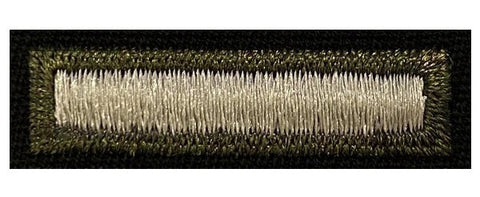Army Overseas Service Stripe: How To Wear

When one serves in the U.S. Army, they may find themselves stationed in various corners of the world. Each deployment carries its own set of challenges, experiences, and personal growth, especially those assignments that are overseas.
Recognizing the value of these overseas assignments, the Army has a unique way of acknowledging and honoring service members who have dedicated a significant portion of their careers abroad. Soldiers who serve overseas are eligible to earn the Army Overseas Service Stripes.
The History of Overseas Service Stripes
The Army Overseas Service Stripes have a long history dating back to World War I. These stripes were introduced to recognize the time military personnel spent in war theaters. The original intent was to show visible honor and pay tribute to those who had undertaken the strenuous and often perilous duty of serving overseas during wartime. Today, they continue to be symbols of dedication, sacrifice, and international service.
The stripes and their placement
Army Overseas Service Stripes represent six months of duty in an overseas location. So, one stripe reflects that the soldier served for six months overseas. They are typically embroidered diagonally on the lower part of the sleeve, with the bottom edge of the first stripe placed three inches from the edge of the sleeve and succeeding stripes placed three inches apart. The color of the stripes (silver or gold) and the material depend on the Army uniform and the individual's service.
Army Overseas Service Stripes are placed on the right sleeve of the service uniform. Service stripes on the left sleeve of an enlisted soldier means one stripe for every three years of Army service with no overseas requirement. Officers do not wear service stripes, but they can wear Army Overseas Service Stripes.
Large overseas stripes are gold in color and made of Rayon. They are 3/16 inches wide 15/16 inches long, on a green background that forms a 3/32-inch border around the bar. Enlisted soldiers must wear large overseas service bars with large rank and service stripe insignia. If wearing the small stripes, those will be gold, made of Rayon, and they are 5/32 inch wide and 13/32 inch long, on a green background that forms a 5/64-inch border around the bar. Enlisted soldiers must wear small overseas service bars with small rank and service stripe insignia.
Who’s Eligible for Overseas Service Stripes in the Army?
Eligibility for Army Overseas Service Stripes is not automatic and is contingent on specific criteria. Service members must meet the following requirements to receive overseas service stripes:
Active-duty status
To receive Army Overseas Service Stripes service members must be on active duty and participate in an overseas deployment or permanent change of station (PCS).
Length of overseas service
The minimum time requirement to earn Army Overseas Service Stripes is 48 consecutive days or 60 non-consecutive days of overseas service. Each additional six-month period merits an additional stripe.
Qualifying locations
Soldiers must serve in a designated area of eligibility to qualify for Army Overseas Service Stripes. These areas are typically specified by their high operational tempo and the associated level of personal risk or hardship.
Most veterans of World War II, Korean War, Vietnam War, Global War on Terror and even the Cold War are eligible for the Army Overseas Service Stripes, as are soldiers who participated in other military operations. If you’re still in the Army, check with your human resources NCO and if you are retired or a veteran, check with your service to ensure the Army Overseas Service Stripes are on your record if you in fact have earned them.
The Process of Awarding and Wearing Overseas Service Stripes
The process of receiving and wearing Army Overseas Service Stripes is fairly straightforward but requires attention to detail. Soldiers are typically responsible for keeping their overseas service records up to date. They should ask their S-1 or human resources section for assistance to ensure that Army Overseas Service Stripes are included in their personnel records.
General uniform regulations
Wearing the Army uniform correctly is a point of pride and a demonstration of military bearing. Army Overseas Service Stripes should be worn on the service uniform or dress uniform, as appropriate.
FAQs about Army Overseas Service Stripes
Below are answers to some common questions regarding overseas service stripes:
Do temporary duty assignments count towards overseas service stripes?
Yes, as long as they meet the minimum time requirements, temporary duty assignments can count towards the eligibility for overseas service stripes.
Can I receive multiple overseas service stripes for service in different locations?
Yes, each six-month period of service in a new location of eligibility will result in an additional overseas service stripe.
Can I receive credit for serving in a hazardous duty area?
Service in certain hazardous duty areas may warrant additional recognition or awards, but overseas service stripes themselves are not differentiated based on the level of hazard. What qualifies a soldier for the stripe is service overseas.

Significance of Army Overseas Service Stripes
Army Overseas Service Stripes are a powerful symbol of service and a distinctive element of the Army uniform. They narrate a silent story of global service, commitment, and the indomitable spirit of the American soldier. Understanding the significance of these stripes only deepens our appreciation for the men and women who wear them and the service they represent.
In the end, these regulations are not just about adding a touch of color to uniform sleeves; they are about recognizing the complex and often challenging responsibilities that come with overseas military service. They are about commemoration and acknowledgment — both collective and personal. In honoring these regulations, we honor the heart of the Army's service and the tradition that propels it forward.


Comments on this post ( 0 )